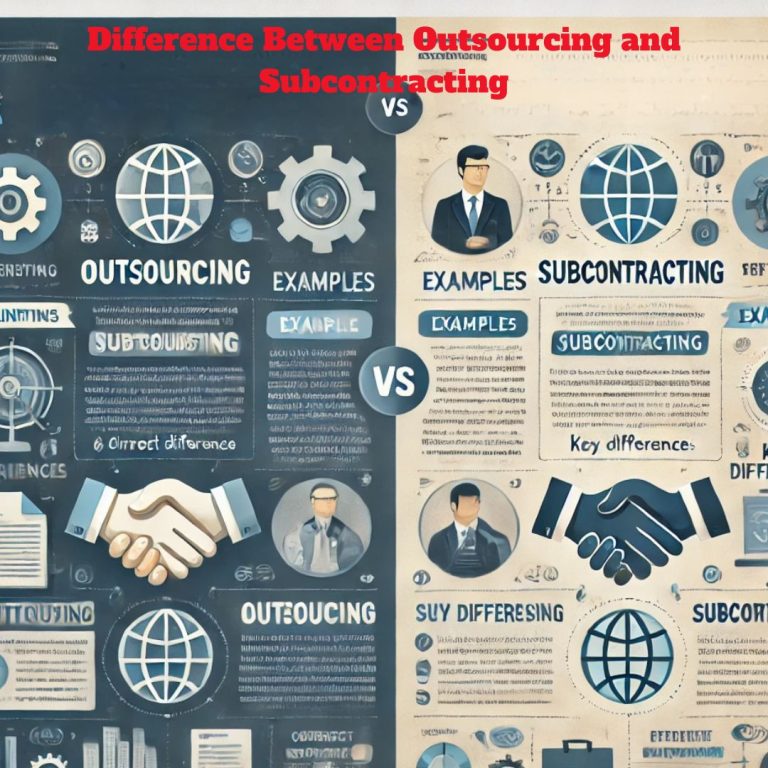The Difference Between Outsourcing and Subcontracting lies in their scope and purpose in business operations. Both involve delegating tasks to external parties, but outsourcing focuses on transferring entire processes or functions, while subcontracting involves hiring external entities for specific tasks within a project. These approaches enable businesses to optimize costs, access specialized skills, and improve efficiency. Understanding their distinctions is vital for selecting the right strategy to meet organizational goals effectively.
Understanding Outsourcing and Subcontracting: Definitions and Basics
What is Outsourcing?
Outsourcing refers to the practice of transferring specific business processes or functions to an external service provider. It often involves a long-term arrangement where an external entity manages and executes operations on behalf of the company.
Examples of Outsourcing
- IT support services.
- Payroll management.
- Customer service call centers.
What is Subcontracting?
Subcontracting is the delegation of specific tasks or components of a project to external contractors. It typically occurs within a larger project, where the subcontractor completes a defined portion under the supervision of the primary contractor.
Examples of Subcontracting
- Hiring a contractor for electrical work in a construction project.
- Engaging freelance graphic designers for a marketing campaign.
Advantages and Challenges of Outsourcing
Advantages of Outsourcing
- Cost Savings:
- Reduces operational costs by leveraging economies of scale.
- Minimizes the need for hiring and training in-house employees.
- Access to Expertise:
- Enables businesses to utilize specialized skills and technologies.
- Focus on Core Competencies:
- Frees up internal resources for strategic activities.
- Scalability:
- Facilitates quick scaling of operations based on demand.
Challenges of Outsourcing
- Communication Issues:
- Differences in time zones and language barriers may cause misunderstandings.
- Loss of Control:
- Limited oversight over outsourced processes.
- Quality Concerns:
- Inconsistent quality if the service provider lacks adequate resources.
- Security Risks:
- Potential data breaches when sensitive information is shared externally.
Benefits and Risks of Subcontracting
Subcontracting would allow firms to pass certain duties to specialized third parties, which enhances efficiency and focus. However, risks include dependence, quality control problems, and the possibility of legal dispute.
Benefits of Subcontracting
- Task Specialization:
- Engages experts for specific tasks, ensuring higher quality.
- Flexibility:
- Allows businesses to handle fluctuating workloads without hiring full-time staff.
- Faster Project Completion:
- Delegating parts of a project speeds up the overall timeline.
- Cost-Effectiveness:
- Reduces overhead by paying subcontractors only for completed work.
Risks of Subcontracting
- Coordination Challenges:
- Requires effective communication to align tasks with project goals.
- Dependency:
- Over-reliance on subcontractors may disrupt projects if they fail to deliver.
- Legal Liabilities:
- Improper agreements may lead to disputes or liability issues.
- Quality Control:
- Ensuring consistent quality across subcontractors can be difficult.
Choosing Between Outsourcing and Subcontracting: Factors to Consider
Factors to Consider
- Nature of Work:
- Opt for outsourcing for ongoing functions (e.g., HR, IT).
- Choose subcontracting for specific, temporary tasks (e.g., construction, design).
- Cost Implications:
- Assess which approach offers greater cost efficiency for your project or business.
- Control Requirements:
- Subcontracting allows closer supervision compared to outsourcing.
- Expertise Needed:
- Outsourcing is ideal for specialized, large-scale operations.
- Subcontracting suits one-off, skill-specific tasks.
- Risk Tolerance:
- Evaluate the risk of data breaches in outsourcing or project delays in subcontracting.
Practical Scenario
A tech company may outsource its customer support but subcontract app development to freelancers for short-term projects.
Key Differences Between Outsourcing and Subcontracting
Outsourcing as well as subcontracting refers to transferring tasks to third parties, but are different in scope, control, and strategic intent. Understanding their key differences helps businesses choose the right approach for efficiency and cost management.
| Aspect | Outsourcing | Subcontracting |
| Definition | Delegating entire business functions. | Hiring for specific tasks within a project. |
| Scope | Long-term and broader in scope. | Short-term and task-specific. |
| Control | Limited control over the external provider. | Greater control over subcontractor tasks. |
| Focus | Enhances core business efficiency. | Supports project completion. |
| Examples | Outsourcing payroll services. | Subcontracting plumbing in construction. |
Key Insights
- Outsourcing focuses on operational efficiency, while subcontracting emphasizes project delivery.
- Subcontracting allows more direct oversight, making it ideal for critical or sensitive tasks.
Conclusion
The Difference Between Outsourcing and Subcontracting highlights their unique roles in business strategy. Outsourcing optimizes operations by transferring functions to external specialists, making it suitable for long-term efficiency. Subcontracting, on the other hand, focuses on task-specific execution, aiding in timely project completion. Both approaches offer distinct benefits and challenges, and the choice depends on organizational needs, resources, and goals. Combining the two effectively can lead to cost savings, operational flexibility, and superior outcomes.
Difference Between Outsourcing and Subcontracting FAQs
What are common examples of outsourcing?
Examples include outsourcing customer service, payroll, and IT support to external providers.
How does subcontracting differ from outsourcing?
Subcontracting involves delegating specific tasks within a project, while outsourcing transfers entire processes or functions to external entities.
What are the risks of outsourcing?
Key risks include data breaches, loss of control, and communication issues due to geographical or cultural differences.
Is subcontracting better for short-term projects?
Yes, subcontracting is ideal for temporary, task-specific projects requiring specialized skills.
Can businesses use both outsourcing and subcontracting simultaneously?
Yes, businesses often combine outsourcing for operational tasks and subcontracting for project-specific needs to optimize efficiency.

